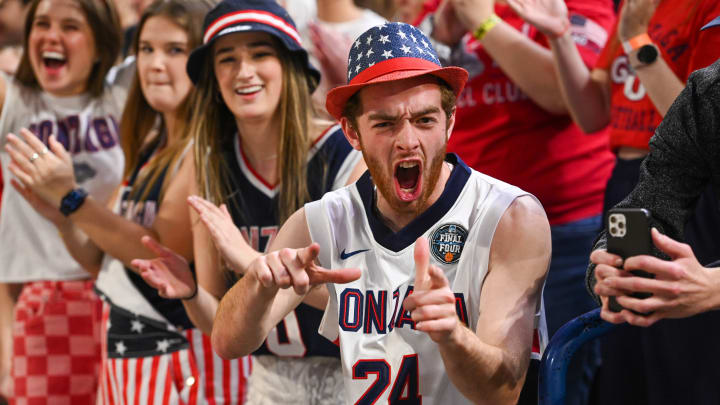How loud is Gonzaga's student section? 'I don’t think it’s matched in any other gym'

There are very few settings in college basketball that compare to the McCarthey Athletic Center, which is heading into its 20th season as the home of the Gonzaga Bulldogs.
Since the intimate 6,000-seat arena opened in 2004, the Zags have won 93.9% of their home games (279-18) and once boasted a 75-game win streak that spanned five years from 2018-2023. Including last season, they’ve won 104 out of their last 108 games inside The Kennel.
No other program in the country has a higher winning percentage at home over the last six seasons than Gonzaga, which is 90-3 at home in that span. The talent and coaching speak for themselves on the floor, but another key component baked into that success is a rowdy student section of 1,200-strong, also known as the Kennel Club.
“I don’t think it’s matched in any other gym I’ve been in,” said Gonzaga men’s basketball alum and a key contributor to the program’s first NCAA Tournament appearance in 1995, Jason Rubright, on the Kennel Club. “The enthusiasm, the passion that the students have ... it’s just a really cool thing to be part of the Kennel Club. They’re basically the sixth man.”
The student-led social club looked a little different during Rubright’s days as a Zag. His house was the club’s gathering spot for both pre-and-postgame festivities, no matter the outcome of the ballgame, and it was a simpler operation than what it’s become today. Not to mention the energy in the 2,000-seat Martin Centre during the 1990s was different than the vibes of the current McCarthey Athletic Center.
Of course, a lot has changed about the men’s basketball program over the last three decades. In Rubright’s era, the warmups they wore before games were hand-me-downs; nowadays student-athletes across many sports have more gear than they know what to do with. Making the second weekend of the NCAA Tournament was an unbelievable accomplishment; now the Sweet 16 has become the benchmark for success.
“It wasn’t a fluke, we worked hard to [make the 1995 NCAA Tournament] and it was cool,” Rubright said. “But it certainly wasn’t something we thought was gonna be sustainable. We thought maybe, once every couple of years … you have a good season, you get to do it again. No idea it was gonna turn into what it is now … the powerhouse that it has turned into … it really doesn’t even sink in.”
A lot has changed in regard to the program’s success, but the program and university’s approach haven't differed much at all.
“That’s another thing I’ve always been impressed with GU about is the fact that the players and the coaches and everything have still been very connected with the student body and the faculty and everyone around the school. And I think that’s a large part of the success,” Rubright said. “The students at GU, because it’s a smaller university, they interact with the athletes on a daily basis. It’s not a huge university so they get to see the guys and they get to be friends with the players. They’re cheering for someone that they know.”
Rubright shared tales of his playing days at Gonzaga, including Mark Few and why he hasn’t changed a bit, on a new episode of Forever Zags.
WATCH THE FULL EPISODE BELOW:
Produced by Thomas Gallagher.
FOLLOW GONZAGA NATION ON SOCIAL MEDIA
Continue to follow our Gonzaga coverage on social media by liking us on Facebook and by following us on Instagram and Twitter @GonzagaOnSI.
